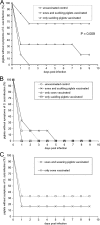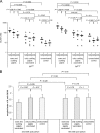Immunogenicity of an autogenous Streptococcus suis bacterin in preparturient sows and their piglets in relation to protection after weaning
- PMID: 20739502
- PMCID: PMC2953004
- DOI: 10.1128/CVI.00159-10
Immunogenicity of an autogenous Streptococcus suis bacterin in preparturient sows and their piglets in relation to protection after weaning
Abstract
Streptococcus suis is an important porcine pathogen causing meningitis and other invasive diseases in piglets of different ages. Application of S. suis serotype 2 bacterins to specific-pathogen-free (SPF) weaning piglets has been demonstrated to protect against the homologous serotype. However, autogenous S. suis bacterins are also applied to sows and suckling piglets in the field. Therefore, comparative evaluation of different bacterin immunization regimes, including sow vaccination, was performed in this study. The main objectives were to determine the immunogenicity of an S. suis bacterin in sows prepartum and its influence on active immunization of piglets. Experimental infection of 6- and 8-week-old weaning piglets was performed to elucidate protective efficacies. Humoral immune responses were investigated by an enzyme-linked immunosorbent assay (ELISA) measuring muramidase-released protein (MRP)-specific IgG titers and by opsonophagocytosis assays. Bacterin application elicited high MRP-specific IgG titers in the serum and colostrum of sows, as well as opsonizing antibodies. Piglets from vaccinated sows had significantly higher MRP-specific titers than respective piglets from nonvaccinated sows until 6 weeks postpartum. Vaccination of suckling piglets did not result in high MRP-specific titers nor in induction of opsonizing antibodies. Furthermore, neither vaccination of suckling nor of weaning piglets from immunized sows was associated with a prominent active immune response and protection at 8 weeks postpartum. However, protection was observed in respective 6-week-old weaning piglets, most likely because of protective maternal immunity. In conclusion, this study provides the first results suggesting protective passive maternal immunity for S. suis serotype 2 after bacterin vaccination of sows and a strong inhibitory effect on active immunization of suckling and weaning piglets, leading to highly susceptible growers.
Figures





References
-
- Amass, S. F., G. W. Stevenson, B. D. Vyverberg, T. W. Huxford, K. E. Knox, and L. A. Grote. 2000. Administration of a homologous bacterin to sows prefarrowing provided partial protection against streptococcosis in their weaned pigs. Swine Health Prod. 8:217-219.
-
- Baums, C. G., and P. Valentin-Weigand. 2009. Surface-associated and secreted factors of Streptococcus suis in epidemiology, pathogenesis and vaccine development. Anim. Health Res. Rev. 10:65-83. - PubMed
Publication types
MeSH terms
Substances
LinkOut - more resources
Full Text Sources
Other Literature Sources
Medical

